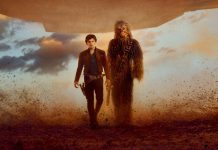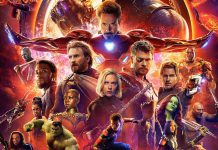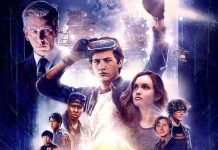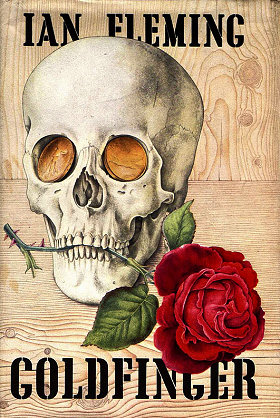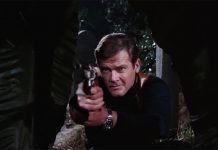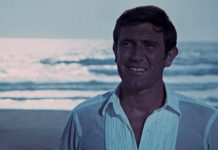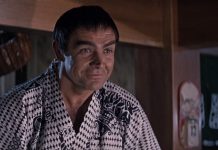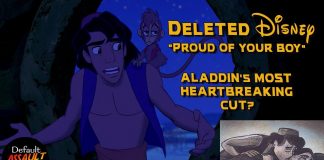Goldfinger. When one thinks of James Bond, especially classic Bond, there is no other title as synonymous with the character (even though the title is, funny enough, refers to another character). Often touted by many as the definitive Bond film, not to mention the very best in the franchise, its reputation transcends the series, gaining a legendary status in the genre. If you were to ask anyone on the street if they’ve seen an old 007 movie, or at least one starring Sean Connery, odds are that this would be it.
Perhaps it is the most definitive film in the series – few may argue that. Goldfinger solidifed the Bond formula (for better or worse) that most every consequent film would follow; but is the best?
Goldfinger (1964) |
Goldfinger finds James Bond 007 (Sean Connery) investigating the mysterious, world-renown bullion dealer Auric Goldfinger (Gert Fröbe) in Miami, Florida. After Bond recklessly thwarts his villainous card-cheating racket (which I’m going to dub Operation Trump Card) by seducing Goldfinger’s accomplice, the insanely beautiful Jill Masterson (Shirley Eaton), James quickly finds himself in over his head as he is helpless to prevent the most blinged-out murder in cinema history.
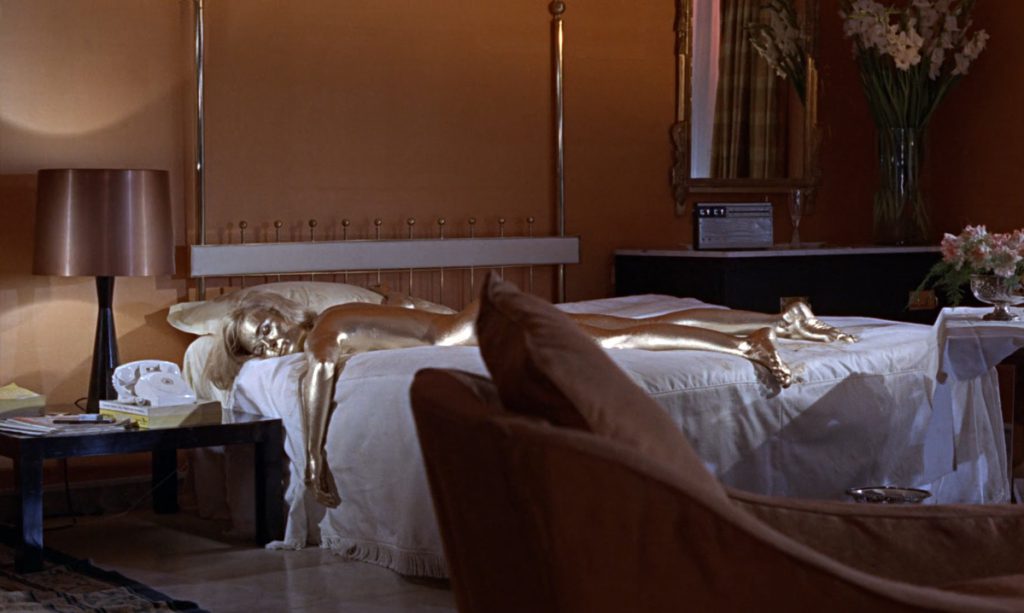
After Bond receives further instructions at MI6, we are introduced to the biggest breakout star of the series – the Aston Martin DB5.

Decked out with countless unforgettable gadgets such as forward shooting machine guns, oil slick, smoke screens, and, most famously, an ejector seat, the Aston Martin DB5 is every car enthusiasts’ dream; or, with its rotating license plate feature, anyone who’s ever gotten a parking ticket’s dream.
With his inconspicuous, killer roadster in store, Bond pursues Goldfinger to Switzerland where he again finds himself in over his head when he crashes the Aston into a brick wall, fails to save another Masterson sister, Tilly (Tania Mallet), who is killed via lethal bowler hat, is subjected to laser torture, and finally, perhaps worse of all, is kidnapped and taken to Kentucky.
When one thinks of James Bond, one of the thoughts that follows hours of perusing through the long history of Bond girls is 007’s association with exotic locales and adventures. The Caribbean, Paris, the Greek Islands, Kentucky…one doesn’t seem to quite fit. And how does director Guy Hamilton convincingly set the stage that 007 is now in the bluegrass state? Why, he naturally shows the storefront of a Kentucky Fried Chicken, of course!
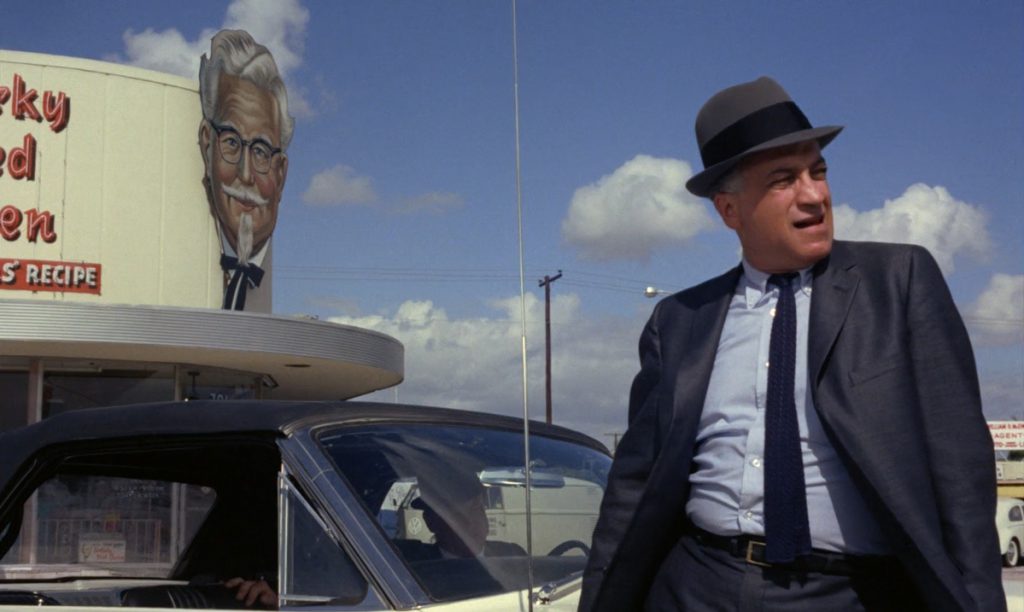
It’s a miracle the film didn’t feature a scene of Bond and Goldfinger dining with a bucket of Colonel Sanders’ finest…

Goldfinger: “No, Mr. Bond. I expect you to enjoy the 11 secret herbs and spices!”
It is here where Bond meets the infamous Pussy Galore (Honor Blackman), a lesbian pilot and leader of an all-girl flying team (their introduction punctuated by a now cliche saxophone riff), and discovers Goldfinger’s master plan: Operation Grand Slam.
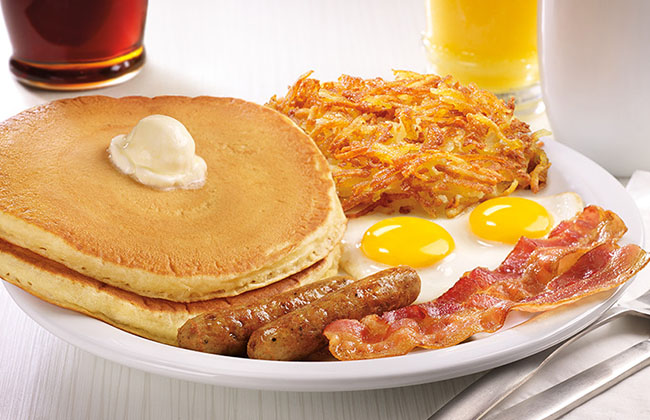
Overhearing Goldfinger’s plot, which we come to find out is a plan to irradiate the gold supply of Fort Knox with a nuclear bomb (suddenly Kentucky makes sense!) and inflate the market in his favor, Bond tries to send CIA agent Felix Leiter (Cec Linder) a warning but once again fails. In desperation, Bond forces himself onto Pussy, reawakening her heterosexuality and prompting her to contact Felix in his stead. After a small scale war breaks out at Fort Knox (whose mysterious interior is marvelously created by production designer Ken Adam), Bond attempts to deactivate the nuclear bomb…and finds himself in over his head until the CIA arrives in the nick of time.
See a pattern? For a film that truly propelled James Bond into super stardom, he practically fails at everything outside of hand-to-hand combat and homosexual conversion therapy (though, to be fair, it is only hinted that Pussy is a lesbian in the film unlike the novel it is based on). Perhaps more so than any other Bond film, Goldfinger (barring the unrelated opening teaser) practically displays an incompetent Bond. On one hand, it is definitely more engaging to pit him as an underdog against a superior villain (and Gert Fröbe’s Goldfinger is definitely among the strongest in the series), but many of Bond’s failures are ultimately his own, such as: his arrogant, unguarded seduction of Jill Masterson which leads to her murder; her sister also meeting her fate under his direction; his Aston Martin being literally defeated by seeing its own reflection in a traffic mirror…
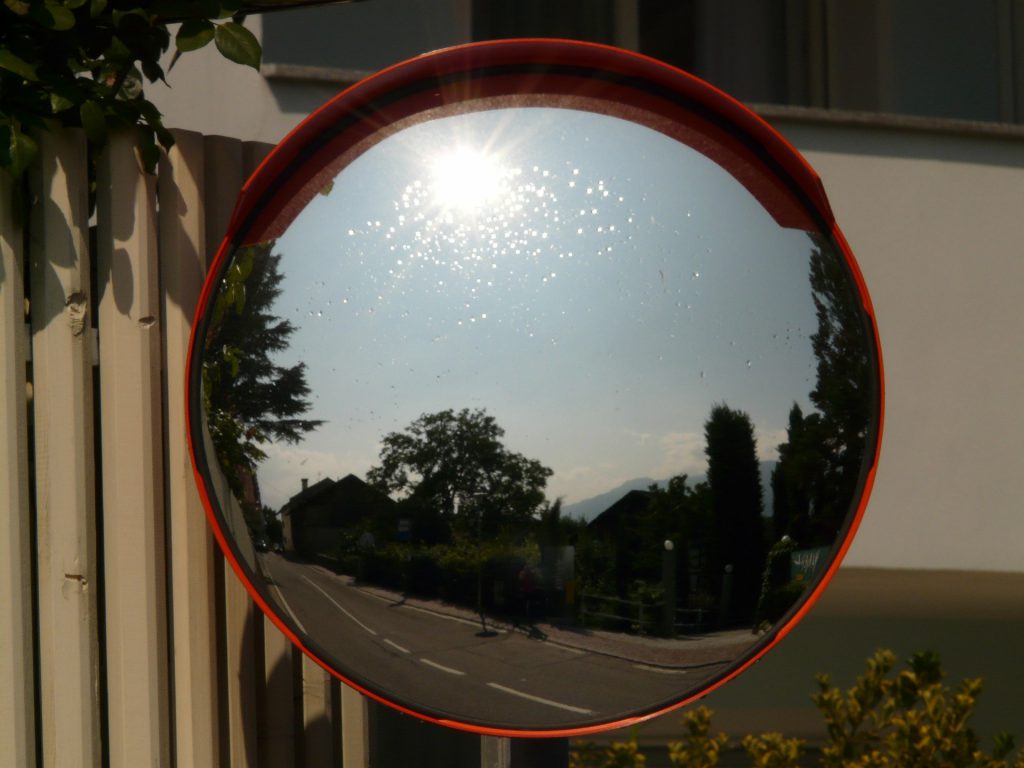
…and his being unable to defuse a bomb by overlooking the on/off switch (no exaggeration – that’s exactly what happens). Yet, it’s Sean Connery’s overpowering presence that helps mask these character flaws from ineptitude to human. Fully coming into the character after his superb performance in From Russia with Love, Connery is exhilarant and dripping with confidence and style.
And “style” is the key word here. From John Barry‘s incredible score (his best in the series) to Ken Adam’s masterful set-design to many little moments that have become celebrated in Bond lore (such as Bond’s white tuxedo reveal under his wetsuit, the first true Q-branch scene with Desmond Llewelyn, and the infamous “I expect you to die” exchange), Goldfinger is a perfect example of style over substance. Though this sounds harsh, this approach not only works for Goldfinger but imbues the film with a distinct character. It’s hard not to watch it without realizing that it’s something special.
In fact, for the first half of the film from the teaser to Bond’s capture in Switzerland, Goldfinger is the best 007 film. Maintaining a great pace with interesting characters, exchanges, and locations (plus a mix of some good old fashioned spy fantasy), the film’s first half is masterful by all accounts…until they arrive in Kentucky, that is. Despite the jests above, Kentuckians would be relieved to discover that it’s not their state’s fault – it’s the screenplay’s.

For the next 30 minutes (which is a considerable amount of time when noting that it is tied with Dr. No as the second shortest Bond film), we as an audience are trapped along with Bond at Goldfinger’s farm and the film comes to a crashing halt. This section of Goldfinger serves for prolonged padding, such as a scene featuring a pointless murder/body disposal of a gangster we just met and care nothing about, and long exposition in the form of Goldfinger outlining his master plan in great detail to a group of gangsters (meeting every cliche in the book) who he kills afterward anyway. Heck, even Felix Leiter who has been watching Bond in a stakeout (and eating KFC), seems bored and proclaims that he’s better off sleeping at his hotel.
Thankfully, the film finds its footing again with the impressive showdown at Fort Knox, highlighted by an epic battle between 007 and the mute, practically indestructible Oddjob (Harold Sakata) and his deadly bowler hat. Oddjob, like many of the characters in Goldfinger, owes more to the inimitable Harold Sakata than to Ian Fleming. With his devilish smile and fierce disposition, Oddjob is a cartoon strongman come to life.
Despite my affinity for the gold painted Shirley Eaton…

…it is the ridiculously named, and often parodied, Pussy Galore that has gone down (bad choice of words) as one of the most memorable Bond girls in the series; although, how much of that infamy is solely due to the character’s name is up for debate. Written throughout as a cold, strong woman (with a weird ambition of buying an island to “go back to nature”), her sudden off-screen turn towards Bond’s side comes as a bit of a whiplash. Sure, it’s part of the fantasy, but it would have been nice to get to know Pussy Galore a bit more intimately (there are no words).
Returning franchise characters get a chance to get a bit more fleshed out, including a dinner party with M (Bernard Lee) and, more memorably, Desmond Llewelyn really growing into his own as the constantly frustrated Q. Felix Leiter returns after skipping From Russia with Love, this time played by Cec Linder (replacing Dr. No‘s Jack Lord) and setting a precedent of different actors playing the part for all the character’s appearances bar a couple of exceptions.
Unlike most Bond films featuring the character, Felix is far more instrumental (not to mention competent) to the plot of Goldfinger than usual, going as far as organizing the raid on Fort Knox and saving an entire city from Goldfinger’s deadly nerve gas (with the tip-off from Pussy..um, that’s it! I’m sticking with Miss Galore!). As good as Cec Linder’s performance is as the character, the change from Jack Lord is quite striking. Linder comes off as a kindly, older man and is far from Bond’s American other. In a fire fight, I’d wager that a gust of wind would knock him down faster than the bullets would. With that said, it’s a rarity to see him have such a consequential role in the story and Goldfinger justifies the inclusion of the character far more than a walk-on name-drop for Bond fans.
Ian Fleming’s Goldfinger |
The film version of Goldfinger, much like From Russia with Love, is one of the few times where a direct adaptation of a Fleming story is improved upon. For the most part, both the film and the novel (Fleming’s seventh in the series) are very similar save for a major change that gives the film much more creative clout. While the book has Goldfinger simply planning on breaking in and stealing the gold from Fort Knox, the film slyly has Bond pointing out the tremendous fallacy of such an undertaking and adds the twist of Goldfinger irradiating the gold to bump up his stake in the market. An ingenious twist and one that strengthens the mystery of the film.
Other changes include a shorter role for the second Masterson sister who, surprisingly, has a thing for the book’s clearly lesbian Pussy, err, Miss Galore. She survives until the novel’s climax when she is offed by Oddjob who, in turn, meets his end after getting sucked out of a plane window (a fate given to Goldfinger in the film). Bond’s seduction of Miss Galore’s inner heterosexuality, as silly a concept as it is, is the kind of vulgar feature that greatly amused Fleming in his many of his works.
Heroin Flavored Bananas |
If one were to look for a scene in the series that totally encapsulates everything that James Bond is about, one can do no better than the pre-credits teaser of Goldfinger. A stunning opening, it sets the perfect tone for the film and the franchise henceforth. From Connery’s introduction via a fake seagull atop his wetsuit, to the infiltration of a hidden drug den (exporting heroine “flavored” bananas), to a climactic brawl with a killer and a bathing femme fatale, the teaser in its entirety is a wonder that is surprisingly brutal, shocking (positively), and sexy, remaining grounded despite a number of ridiculous elements.
Bond’s hotel room showstopper brawl is one of the series’ best (falling just short of From Russia‘s train fight with Robert Shaw) and proves a good bit of foreshadowing with Bond swiftly electrocuting the villain similarly to his dispatchment of Oddjob, providing the film with electrifying bookends.
With a blaring opening chord, we hear what is simply the most iconic James Bond title tune of them all – “Goldfinger,” sung by the incomparable Shirley Bassey (who would also go on to sing the title songs for Diamonds Are Forever and Moonraker – the only performer to do more than one Bond film). There’s little I can add to the general praise of the composition other than it’s a bona fide crime that it didn’t pick up a Best Song Oscar (it wasn’t even nominated!), especially when one considers the fact that SPECTRE‘s passable “The Writing’s on the Wall” did (the only other Bond Song to win, “Skyfall” was contrarily quite deserving). Then again, had it been nominated, it would have gone up against “Chim Chim Cher-ee” from Disney‘s Mary Poppins – a losing situation if there ever was one.
The credits themselves are as iconic as the song, complementing the tune perfectly. In an inverse of From Russia with Love‘s titles that featured a belly dancer with the credits projected onto her, Goldfinger features scenes from the film (as well as the previous entries) projected onto a gold painted girl. The set-up of the shots is mesmerizing, providing a glimpse of adventures to come in an almost hypnotic fashion, such as a creative sequence featuring the Aston Martin being juxtaposed on the model’s face with the license plate rotating along her mouth.

Final Thoughts |
Goldfinger, despite the aforementioned pacing issues, is, as a whole, a gold standard for the series. The production quality, performances, music, and creative flourishes add up to make it one of the most memorable in the series. It’s fitting that it should be the first Bond film to nab the golden statue for Best Sound Editing. Is it overrated? Maybe, but it earns an argument against such allusions in spades. Although it lacks the maturity of From Russia with Love, it makes up for it in sophistication.
Goldfinger marks the last great evolution of Bond, forever separating the grounded approach of Russia from the fantastic. The defining moment may be the most subtle – Bond’s introduction under the guise of the seagull atop his wetsuit. Up to this point, Bond hadn’t been part of the joke. He was a highly-skilled agent navigating the fantasy around him. Goldfinger promotes him as part of the fantastic, weapon-stocked sports car and all. Though the series would return to a more grounded approach from time to time, this is the incarnation of Bond that would endear him to the world. We, as an audience, were no longer with him – we now wanted to be him. This approach, when presented well, elevated future films in the franchise. When it didn’t, the films easily fell into the plague of camp.
The series aside, as a stand alone film, Goldfinger is a joy and one of the best fantasy-action films of the genre. No better recommendation can be given than the words of James Bond himself: “Let’s have a little fun with Mr. Goldfinger.”
Random Afterthoughts… |
The Aston Martin, in all its glory, is decked out with an arsenal of gadgets with one of the most memorable being the aforementioned rotating license plates. It also marks one of the few times a feature is prominently presented in a Bond film that is ultimately never used once throughout. Oddly, the license plate remains static throughout all of the Aston’s scenes outside of Q-branch and the credits!
Although Goldfinger has some nice callbacks to the previous films such as the mention of Bond’s attache case from From Russia with Love, I sometimes wonder if the producers and writers ever sat down to actually watch the previous films. Of course, continuity has never been the series’ strongest point (especially after the first two decades), but there are a few odd bits in the early films that contradict events from their predecessors in favor of the novel series’ continuity (since they were filmed out of order, this isn’t too surprising).
For instance, when Felix first sees Bond in Miami, James, recollecting their last adventure in Dr. No, points out that the opposition got too close to Felix in Jamaica. When the heck did that happen? He spent the entire film wearing ridiculous sunglasses and receiving exposition. The closest he got to the opposition was piloting Bond’s boat halfway (halfway!!) to the villain’s lair before he turned back! Not to mention, he wasn’t even in the novel of Dr. No!
I am convinced that this film should have switched titles with The Man with the Golden Gun. Why? Two points. First:
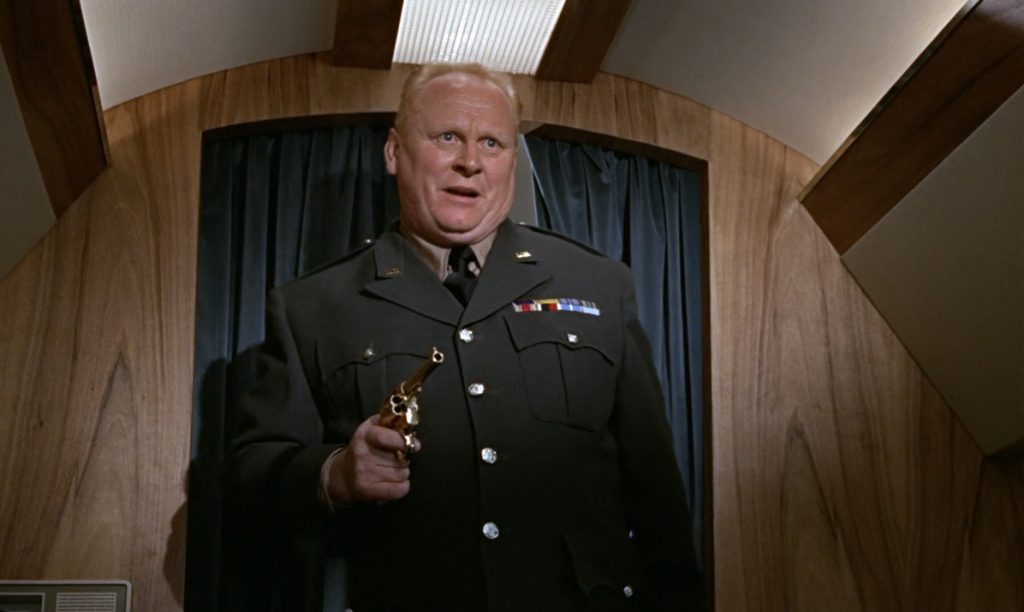
And second: The Man with the Golden Gun was about a villain who had to have sex before he assassinated anyone with his makeshift golden arsenal. If there was ever a time for a villain to be named Goldfinger, that’d be it!
James Bond oddly gives the Beatles a crack when he remarks that Dom Pérignon at the wrong temperature is “just as bad as listening to the Beatles without earmuffs.” Guess someone should have mentioned that to ex-Beatle Paul McCartney when he sang the terrific title tune for Live and Let Die (whose score was also done by legendary “fifth Beatle” George Martin).
This is the only Sean Connery Bond film where he is not pitted against the evil S.P.E.C.T.R.E. organization. Guess they were taking a holiday from death and destruction.
After Bond uses the Aston Martin’s tire-shredding feature to puncture Tilly Masterson’s right-side tires (also shredding the whole side of her car in the process), he runs up to the vehicle proclaiming the rarity of a double blow-out – a fact that Tilly just mildly accepts. What, did she just miss the fact the entire right side of her car was shredded to pieces? Or did she just expect that one of the unfortunate side effects of flat tires was a total explosion of the car’s body work in a rain of debris?

James Bond will Return
in
Thunderball (1965)
Join 007 on the 7th of next month! For more, click here.



